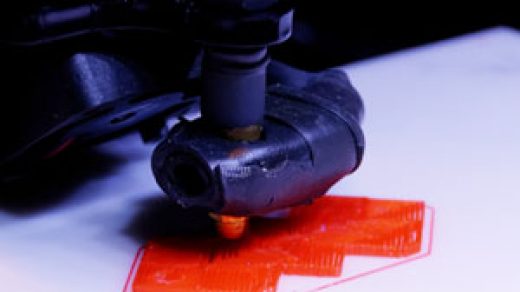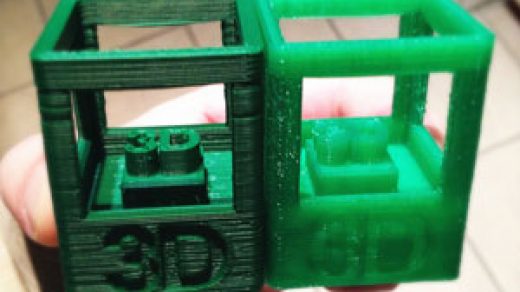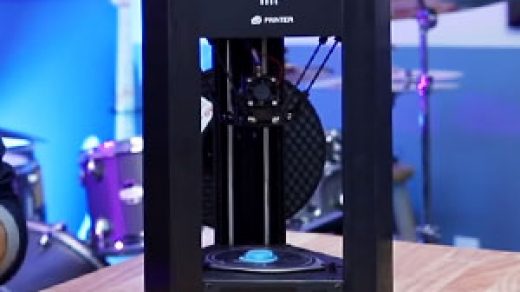
Popular 3D Materials (source)
3D printing has been in existence for quite a while now, but it never stops growing. Every dawn there are new advancements in this field of manufacturing technology.
3D printers in our jobs and our lives make it easy to manufacture models and end-use products made of plastics, metals, composite and other materials.
When choosing printing materials 3D printing experts have to consider factors such as texture, cost and suitability of the filament material to their project.
Below are the ten most popular 3D printing materials
1. Nylon
Nylon is a synthetic thermoplastic material that is most popular in FDM 3D printing. It is known for toughness and flexibility. Nylon filaments usually require printing temperatures of about 250 ºC.
For some brands, however, they can melt at lows of 220 ºC due to their chemical formulation. Since many 3D printers do not have a nozzle that can sustain the high temperatures of 250 ºC, so the lower-temperature nylon versions are more popular.
Pros
- It is robust, flexible and corrosion/friction-resistant
- Nylon filaments are used for projects with complex geometries
- It is easy to add finishing to the final model with dyes or paint
- Nylon filaments are resistant to warping
Cons
- It is hygroscopic which means the material absorbs moisture from the surroundings
- Requires specialized storage to keep it dry
- Nylon filaments have a shelf life of not more than a year
- When cooling after printing, nylon material can shrink and so it interferes with design accuracy
- It might not be the best filament material for all types of 3D printers
2. ABS
Acrylonitrile Butadiene Styrene is another filament material in the thermoplastics family, and it is another favorite for 3D printing enthusiast and experts.
ABS material comprises of polymers including Acrylonitrile, Butadiene, and Styrene. ABS filament is suitable for FDM or FFF printing tech because of its superb plastic qualities.
ABS plastic has a melting temperature of about 200 °C and so, in that case, the filaments can safely be used in consumer-grade 3D printers. In its natural form, the ABS material is white, but the printing process often transforms it into yellow. ABS plastics are used in architectural models, low-cost prototypes and affordable prosthetics.
Pros
- It is lightweight and with an excellent tensile strength
- It is resistant to abrasion
- ABS is tough with reliable heat deflection properties
- The polymers can withstand chemical treatment in post-processing
- ABS filaments are cheap and readily available
- ABS filaments have a longer lifespan than Nylon.
- ABS filament material is mechanically robust.
Cons
- You will need a heated printing bed with ABS filaments
- ABS material can be prone to warping when cooling during and after printing
- ABS plastics are non-biodegradable and also emit toxic fumes and pungent smells into the atmosphere when printing
3. PLA (Polylactic Acid)
PLA filament materials are made from green sources such as cornstarch or sugarcane. PLA is applicable in 3D printing in homes and schools. PLA comes in various colors and styles and is therefore convenient in many applications. PLA is environmentally friendly and consumes less energy when printing.
Pros
- PLA filaments are easy to work within 3D printing because they have low warping
- You don’t need a heated printing bed for this type of material
- PLA has high performance in models of complex dimensions
- PLA filaments are available in many colors and blends
Cons
- PLA materials are not so durable and are prone to deformation under extreme heat
4. PET/PETG
Polyethylene terephthalate is another frequently used 3D printing material. PET is used in thermoforming manufacturing processes. It can also be blended with materials such as glass fiber to form engineering resins. PET filament is transparent, but once it goes through the heating in the 3D printing process, its transparency fades.
PET filaments are lightweight and are used in applications that need to be shockproof. After cooling, PET materials often turn to sturdy crystalline structures.
One can thermoform or mold the part after printing. PET materials also respond well to post 3D printing processes such as polishing and painting.
PETG is a modification of PET. PETG stands for Polyethylene terephthalate glycol-modified. This filament material is more transparent, less brittle, and easier to print with than PET.
Pros
- PET and its variants are all durable
- PET is recyclable
- It is possible to sterilize PET
- Delivers superb layer adhesion
- Just like ABS, PET is strong and temperature resistant
- Just like PLA, PET is easy to print
Cons
- The PET material can get deformed under UV light.
- It is prone to wear and tear
5. Polyamide (PA)
Polyamide materials comprise of polymers containing amide properties. PA 3D printing filaments are available in a variety of formats. In powder form, PA is ideal for SLS 3D printing technology.
PA filaments used in FDM 3D printing technology has to be in wire form. PA filament materials have a wide range of applications in 3D printing of prototypes and consumer products.
Pros
- PA filaments is appropriate for many 3D printing applications
- PA has low shrinkage.
- The material has a considerable chemical resistance
- They offer high precision and high stiffness
- PA is an affordable 3D printing material
Cons
- PA filaments also have a short shelf life
- PA filaments need special storage to prevent deformation under heat
- Prolonged exposure to heat can cause an untimely polymerization
6. PVA
Polyvinyl alcohol (PVA) comes in handy in the making of 3D printing support materials. This type of polymer is soft and biodegradable. PVA is highly soluble in water. The plastic melts at about 200 degrees Celsius.
At high temperature, the material can release toxic fumes and pungent smells. You will need to heat the printed bed for this material to stick well. After printing, you are only required to immerse the final print in water than the OVA supports will get washed away.
PVA makes it easy to print models that require supports, helping to attain design accuracy with complex models. Nevertheless, you need to be cautious when disposing of PVA dissolved water. The residue can clog sinks and drains.
Pros
- PVA is suitable for 3D printing supports
- It is easy to print
- It is highly soluble
Cons
- PVA materials release toxic fumes under high temperatures
- For its solubility, it is not ideal for prototyping
7. High-Impact Polystyrene
Also known as high-density polyethylene HIP is used to produce pipes and recyclable plastic bottles and packages. HIP is a lightweight and highly flexible material that adheres well.
HIP also comes in handy when dying and molding the final print. HIP filament material melts at about 230 degrees Celsius. Like PA, it releases contaminated fumes if printed at higher temperatures.
HIP filaments are preferred over ABS to produce prints that are stronger yet lightweight. The material can also withstand most chemicals apart from limonene.
Pros
- Does not high printing temperatures
- Its solubility in limonene makes it suitable for printing 3D printing supports
- It is lightweight
Cons
- Requires a heated printing bed
- It is prone to warping and contracting during cooling
8. Wood Fiber (Cellulose + PLA)
These are a combination of fine wood particles and PLA materials together with a binding polymer. After printing and polishing, the finished print has that rustic, natural textured wood-like appearance.
There are many versions of wood fiber materials available for different 3D printing applications. You have variations including bamboo, ebony or mahogany.
During the 3DA printing process, you can change the color of the final print by slightly changing the printing temperature. High temperature birth darker prints and you get light looks with lower temperatures.
Pros
- Attractive wood-like appearance
- Requires low printing temperatures
- The right material for printing wood carvings
Cons
- Wood filaments need glue to help the material stick to the printing bed
- The final print require finishing such as sanding and abrasive treatment
- Prone to design inaccuracies
9. Thermoplastic Elastomer (TPE)
TPE is a highly flexible 3D printing material. TPE materials are rubberlike and are ideal for models and parts that require high vibration resistance, impact resistance, flexibility, and non-slip properties.
TPE products are highly durable, deforming and compressing when needed to accommodate big loads. TPE filaments need to be printed at a slower flow rate to get the best results. It is also advisable to print at a low layer height of about 0.1mm to 0.2mm range.
Pros
- Fatigue resistant
- Tear resistant
- Food-contact approved
Cons
- Slow printing speed
- TPE filaments are hygroscopic and therefore need individual storage
10. Ninjaflex & Thermoplastic Urethane (TPU)
Thermoplastic Polyurethane filaments can be used in any decent FDM 3D printer. Unlike other highly flexible 3D printer filaments, TPU tends to be more rigid and therefore easier to print.
TPU is a medium-strength material with high durability and flexibility. TPU filaments can withstand high tensile and compressive forces better than PLA and ABS. The ideal printing temperature for TPU is around 220 degrees Celsius.
Pros
- No need to heat the printing bed
- Has minimal warping
- Resistant to shrinkage
- Abrasion resistance
- Accommodates high printing speed
- Can produce very durable and reliable parts
Cons
- TPU is hygroscopic and therefore needs proper storage
- TPU is not food safe
With the right materials, you can get superb results in your 3D printing projects. With advancement in technology, there will be more 3D printing materials hitting the market. At the moment, the above are the ten best.



